
A medium caliber gun used on the first of France's armored cruisers and on 2nd class cruisers. This weapon was one of a series of guns that were designed to use the new poudre B nitrocellulose propellant. Some of these guns were later used as coastal artillery.
Constructed of thick A tube that was reinforced over slightly more than half its length by a jacket and five hoops. A trunnion hoop was screwed on to the jacket. Used an interrupted screw breech with four threaded and four plain sectors.
Although most secondary sources show this gun as 194 mm, primary documents always list it as 19 cm as per the designation standards of the time. Actual bore size was 194 mm, the same as later guns of this caliber.
| Designation | 19 cm/45 (7.64") Model 1887 |
|---|---|
| Ship Class Used On | Model 1887: Dupuy de Lôme and Amiral Charner class |
| Date Of Design | 1887 |
| Date In Service | 1895 |
| Gun Weight | 23,744 lbs. (10,770 kg) |
| Gun Length | 318.0 in (8.076 m) |
| Bore Length | about 305.5 in (7.760 m) |
| Rifling Length | N/A |
| Grooves | (58) 0.055 in deep x 0.118 in (1.4 mm x 3.0 mm) |
| Lands | N/A |
| Twist | Inclined at 5 degrees |
| Chamber Volume | 2,647 in3 (43.389 dm3) |
| Rate Of Fire | about 1 round per minute |
| Type | Bag |
|---|---|
| Projectile Types and Weights 1 | CI 2- 165.3 lbs. (75 kg)
APC - 199.1 lbs. (90.3 kg) SAPC 3- 197.3 lbs. (89.5 kg) |
| Bursting Charge | CI - 11.2 lbs. (5.07 kg) black powder
APC - 3.5 lbs. (1.590 kg) Mélinite SAPC - 9.5 lbs. (4.330 kg) Mélinite |
| Projectile Length | CI - 22.8 in (58.0 cm)
APC - 20.6 in (52.4 cm) SAPC - 23.2 in (59.0 cm) |
| Propellant Charge | 41.4 lbs. (18.8 kg) BM9 4 |
| Muzzle Velocity | CI - 2,625 fps (800 mps)
APC - 2,525 fps (770 mps) SAPC - 2,525 fps (770 mps) |
| Working Pressure | CI - 13.35 tons/in2 (2,100 kg/cm2)
APC - 13.67 tons/in2 (2,150 kg/cm2) SAPC - 13.67 tons/in2 (2,150 kg/cm2) |
| Approximate Barrel Life | N/A |
| Ammunition stowage per gun | N/A |
- ^"Armored Cruiser Dupuy de Lôme" states that the Model 1887 gun fired 165 lbs. (75 kg) rounds when originally introduced. The heavier rounds were adopted in the late 1890s. "Naval Weapons of World War Two" states that heavier projectiles and higher muzzle velocities were in use during the 1940s.
- ^CI = cast iron.
- ^The SAPC shell was really a steel-body projectile.
- ^Propellant was in two bags.
| Elevation | Distance |
|---|---|
| 14.2 degrees | 12,580 yards (11,500 m) |
As in most ships of this era, long range gunfire was nearly impossible and for that reason the maximum range figures seen in secondary and even primary sources should be viewed with a degree of skepticism. Instead, designers were more concerned about performance at a range where most combats would take place. For these ships, the French considered that 2,000 m (2,100 yards) would be the most likely combat range.
| Shell Type | Remaining Velocity | Drift | Mean error in range | Mean error in line |
|---|---|---|---|---|
| CI | 1,970 fps (600 mps) | 29 in (0.74 m) | 70.0 feet (21.3 m) | 43 in (1.1 m) |
| APC | 2,030 fps (619 mps) | 33.8 in (0.86 m) | 134.5 feet (41.0 m) | 37 in (0.93 m) |
| Designation | Single Pivot Turrets
Dupuy de Lôme (2): Model 1887 1a Amiral Charner (2): Model 1891 2a |
|---|---|
| Weight | N/A |
| Elevation | Dupuy de Lôme: -5 / +15
Amiral Charner: -6 / +14.2 |
| Elevation Rate | N/A |
| Train | Bow/Stern Turrets: about -150 / +150 degrees
Amidships: about -80 / +80 degrees |
| Train Rate | N/A |
| Gun recoil | N/A |
| Loading Angle | N/A |
- ^The M1887 turrets were located amidships and did not use turret races. Instead, the turret stalk rested on a pivot shaft that extended down to the protective deck. The ammunition hoists were inside the shaft and rotated with the gunhouse. Hydraulic rams located at the base of the pivot shaft worked the training mechanisms. Guns were manually elevated. Unusually, the shell and powder magazines were located two sections away from the turret stalk which meant that ammunition needed to move horizontally, presumably by overhead rails, to the gunhouse. The barbette armor ran from the weather deck to about half way up the turret, which was unarmored below this level.
- ^The M1891 turrets were located bow and stern and differed from the M1887 by having handling rooms adjacent to the stalk with the shell and powder rooms located next to them. Latouche-Trèville differed from her sisters in having electrically-operated turrets instead of hydraulically-operated ones. In addition, the turrets were balanced about the central pivot-shaft with the gun also balanced about it trunnions. This design meant that the gunhouse was elliptical in shape rather than circular as had earlier mountings.
"Naval Weapons of World War Two" by John Campbell
"French Warships of World War I" by Jean Labayle Couhat - Ian Allan Series
"Naval Weapons of World War One" by Norman Friedman
"French Armoured Cruisers: 1887 - 1932" by John Jordan and Philippe Caresse
"Armored Cruiser Dupuy de Lôme" by D.B. Yakimovich and A.S. Alexandrov (Marine Campaign 2007, No 5)
"Armored Cruiser Charner" by D.B. Yakimovich and A.S. Alexandrov (Marine Campaign 2008, No 3)
---
Tony DiGiulian's personal files
---
Ministère de la défense
---
Special Help by Michal Derela and John Jordan
28 December 2008 - Benchmark
29 November 2019 - New Datapage split off from 194 mm/50 Model 1902 datapage
31 March 2021 - Added photograph of Dupuy de Lôme


